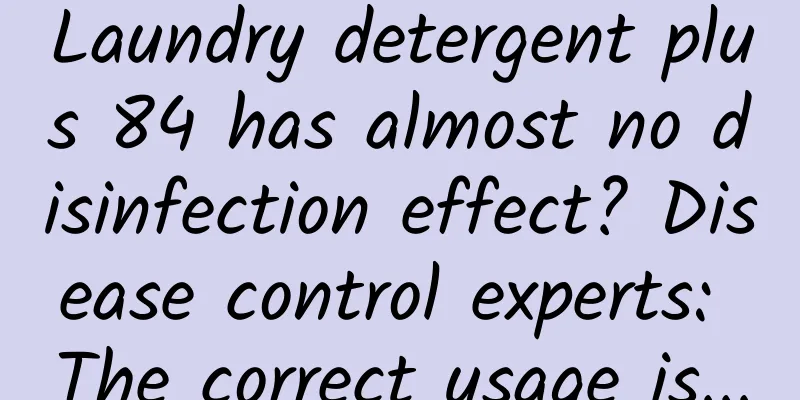Laundry detergent plus 84 has almost no disinfection effect? Disease control experts: The correct usage is...

|
Expert of this article: Yang Chao, PhD in Chemistry, University of Chinese Academy of Sciences During the epidemic, disinfection is a daily must. At the Nanjing Municipal Epidemic Prevention and Control Press Conference held on the 8th, disease control experts reminded: ① Adding 84 to laundry detergent has almost no disinfection effect; ②Spraying disinfectant on clothes is useless and dangerous; ③Do not spray alcohol into the air for disinfection; ④84 disinfectant and toilet cleaner cannot be mixed. The right approach ①Open windows as much as possible to improve ventilation; ② Soak the air filter in chlorine-containing disinfectant... Weibo screenshot However, in daily life, many people's disinfection methods are actually wrong, and excessive disinfection may backfire and even lead to poisoning. So, what is the correct disinfection posture? And what are the precautions? Without further ado, let’s learn together! Laundry detergent + 84, disinfection effect 1+1>2? Answer: No. The main ingredient of 84 disinfectant is sodium hypochlorite (NaClO), which can be hydrolyzed in water to produce hypochlorous acid, a strong oxidant that can kill bacteria. When it is mixed with laundry detergent, although it basically does not react chemically with the main ingredient of laundry detergent, the "surfactant", it will react with benzyl alcohol, an ingredient in the softener in the laundry detergent, and oxidize it into benzaldehyde or even benzoic acid. At the same time, it will produce chlorine gas, increasing the concentration of chlorine in the air, which may cause poisoning. Adding too much 84 disinfectant will also inhibit the activity of the protease added in the laundry detergent and reduce the washing effect. If you are washing cotton, linen, silk, or wool textiles, adding 84 disinfectant will cause the clothes to fade. So, can mixing 84 disinfectant with 75% alcohol solution achieve double the sterilization effect? The answer is no. Experimental results show that 84 disinfectant and alcohol will react to produce chlorine gas, and chloroform has also been detected. Therefore, it is not recommended to mix them. In addition, 84 disinfectant should not be mixed with toilet cleaner. The main ingredient of toilet cleaner is hydrochloric acid, and when the two are mixed, chlorine gas will be produced. Chlorine gas is toxic and volatile. Chlorine poisoning may cause coughing, chest tightness, etc. in mild cases, and breathing difficulties in severe cases. In summary, when using disinfectants and cleaners, just choose one at a time and don't always think about combining two powerful agents. How to use 84 disinfectant correctly? The effective chlorine content of 84 disinfectant is generally 1.1%-1.3%. Its main function is to kill pathogenic cocci and bacterial spores. It is suitable for disinfection of general object surfaces and must be diluted with cold water before use (see the instruction manual for specific usage). (1) Environmental disinfection: When disinfecting the bathroom floor, sewer pipes and other environments, dilute the original liquid with water at a ratio of 1:30, soak for 20 minutes or scrub with a rag or mop, or spray with a plastic bottle. (2) Disinfection of tableware: Dilute the original solution with water at a ratio of 1:10, and soak the utensils to be disinfected in the diluted liquid for 20 minutes. (3) Fruit and vegetable washing: Dilute the stock solution with water at a ratio of 1:50, place the fruits and vegetables to be disinfected in the diluted solution, soak for 5 minutes, and then rinse with clean water. However, if it is not washed thoroughly, there may be chlorine residue, so it is not recommended to use 84 to wash fruits and vegetables. For washing and disinfecting fruits and vegetables, you can use fruit and vegetable cleaner. When using 84 disinfectant, please note: (1) The hypochlorous acid produced by 84 disinfectant is highly oxidizing, so gloves must be worn during the cleaning process; (2) Chlorine gas may be produced during the disinfection process, so please wear a mask and maintain ventilation; (3) 84 disinfectant should be stored in a sealed container and away from light; (4) If 84 disinfectant is stored for more than half a year, the effective chlorine content will decrease and it needs to be diluted by 1 times the original solution before use; (5) It is best not to use it to disinfect clothes, and do not soak them for too long. How to choose hand sanitizer? Hand sanitizers can be divided into two categories based on their active ingredients: 1. Hand sanitizer containing alcohol. Generally, it contains 55%-75% alcohol. The principle of sterilization is to denature and inactivate the protein in microorganisms. At the same time, alcohol is highly volatile. When evaporating, it can take away the moisture in the bacteria, making them dry and dehydrated, thereby achieving the purpose of killing bacteria. 2. Hand sanitizers containing cationic surfactants. Some cationic surfactants also have bactericidal and disinfecting effects. For example, quaternary ammonium-based benzalkonium bromide and benzalkonium chloride are non-oxidizing bactericides with broad-spectrum and high-efficiency bactericidal abilities. They kill bacteria by changing the permeability of bacterial cytoplasmic membranes, causing the cytoplasmic substances of bacteria to extravasate, blocking their metabolism, and thus causing the bacteria to die. Benzalkonium chloride is often used for skin disinfection, mucous membrane and wound disinfection before surgery, but high concentrations of benzalkonium chloride can cause certain irritation and corrosion to the skin and mucous membranes. In addition to benzalkonium chloride, chlorhexidine (also known as chlorhexidine) is also a cationic surfactant that is added to hand-free disinfectants. Its bactericidal mechanism is to change the permeability of bacterial cell membranes and kill most Gram-positive and Gram-negative bacteria, including Staphylococcus aureus, Escherichia coli and Candida albicans. It is particularly emphasized that the "Diagnosis and Treatment Plan for Pneumonia Caused by New Coronavirus Infection (Trial Sixth Edition)" issued by the National Health Commission clearly states that chlorhexidine cannot effectively inactivate the virus. To prevent the new coronavirus, it is more effective to choose hand disinfectant containing 75% alcohol or benzalkonium chloride. Finally, I would like to remind everyone that although hand sanitizers can sterilize and disinfect, they have almost no ability to remove dirt. Therefore, if you want to keep your hands clean and hygienic, you must wash your hands frequently with running water. The pictures in this article with the "Science Popularization China" watermark are all from the copyright gallery. The pictures are not authorized for reprinting. |
<<: When does bayberry ripen? Why can't we eat too much bayberry?
>>: What are the benefits of eating bayberry? Do you need to wash bayberry?
Recommend
Girl hasn't had her period for two months
Menstruation is also known as menstruation, which...
How long does it take for the ectopic pregnancy sac to rupture?
Nowadays, many situations can easily occur during...
What is the cause of vulvar ulcers?
Vulvar ulcers are inflammation, ulceration and da...
What are the reasons why girls don’t want to fall in love?
The number of single people is increasing. Previo...
Is it correct to step on the brake and the accelerator at an angle when driving? How should you step on the brake and the accelerator?
Many people ask how to step on the brakes and acc...
How to grow tiger skin plant and how to make tiger skin plant grow tall
Tiger skin plant, also known as tiger tail palm, ...
What are the hazards of curettage?
Nowadays people's ideas are more open, and ma...
Are zero-sugar drinks a tax on your IQ?
This article was first published by Hey Stone Hea...
An overlooked source of salt: mustard tuber
Salt is the most important condiment in life. In ...
Can adenomyosis drink brown sugar?
Nowadays, many women have irregular menstruation,...
What to do if a girl develops slowly
After entering puberty, both girls and boys enter...
What is the reason for milky white vaginal discharge?
If the leucorrhea appears abnormal, such as milky...
Maternity supplies preparation list
After ten months of pregnancy, the baby is born. ...









